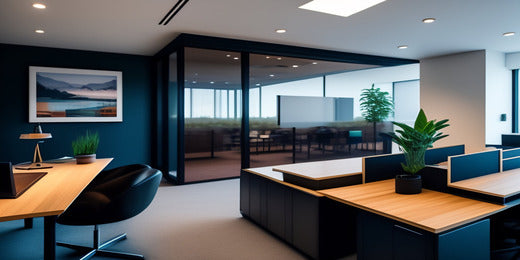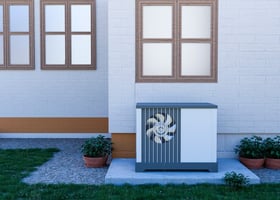Unlocking Comfort and Efficiency: How to Optimize Your Office for Air Conditioning
In the realm of modern workspaces, where productivity and employee well-being are paramount, the concept of comfort extends far beyond ergonomic chairs and tasteful décor. It encompasses an essential element that often operates quietly in the background but wields a significant influence on the overall office experience – air conditioning (AC).
In this article, we will delve into the crucial role that air conditioning plays in achieving this goal. We will explore the fundamentals of office AC systems, discuss how to assess your office's unique cooling needs, and highlight the importance of energy efficiency and sustainability. Additionally, we will delve into the realm of smart AC control systems, optimization of air conditioner placement and airflow, and the significance of regular maintenance.
Moreover, we will guide you in creating an AC-friendly workspace that ensures your employees are comfortable year-round. Understanding the link between employee comfort and productivity will underscore the importance of an optimized air conditioner system in your office.
As we embark on this journey, you'll gain valuable insights and practical tips to transform your office environment into a haven of comfort and efficiency, where both you and your employees can thrive. Let's unlock the secrets to achieving an ideal office climate, optimizing your space for air conditioning, and reaping the benefits of a harmonious workplace.

Understanding Office Air Conditioning
Air conditioning (AC) is the unsung hero of office environments, silently working to maintain a comfortable climate that fosters productivity and employee well-being. To harness the full potential of your office AC system, it's essential to comprehend its fundamentals, the various types commonly found in offices, and the critical importance of proper maintenance.
Basics of Office Air Conditioning Systems
At its core, an office AC system is designed to regulate the indoor temperature, humidity, and air quality, creating a comfortable and controlled environment for occupants. Here are the fundamental components and principles of office air conditioning:
- Centralized Cooling: Many office buildings employ centralized AC systems, where a single unit or series of units cool the entire workspace. These systems use a network of ducts to distribute conditioned air evenly.
- Temperature Control: Office air conditioner systems allow for precise temperature control. Thermostats are placed strategically throughout the space to monitor and adjust the temperature as needed.
- Air Filtration: AC systems include air filters that trap dust, allergens, and pollutants, ensuring that the circulated air is clean and healthy.
- Refrigeration Cycle: AC systems use a refrigeration cycle to cool the air. This involves the evaporation and condensation of a refrigerant fluid, which absorbs heat from the indoor air and releases it outside.
Types of AC Systems Commonly Used in Offices
Office AC systems come in various types, each with its own advantages and applications:
- Split System AC: This is a common choice for smaller offices. It consists of an indoor unit (evaporator) and an outdoor unit (condenser). The two units are connected by refrigerant lines and circulate air through the space.
- Window AC Units: Often used in individual offices or small meeting rooms, window AC units are cost-effective and easy to install. They are placed in a window or a hole cut in a wall.
- Ductless Mini-Split AC: Suitable for offices without existing ductwork, mini-split systems offer zoned cooling. They consist of an indoor unit mounted on the wall or ceiling and an outdoor unit.
- Central AC Systems: Larger office buildings typically use central AC systems. These systems cool the entire building, offering consistent temperature control throughout.
Significance of Proper AC Maintenance
Proper maintenance of your office air conditioner system is not just a routine chore; it's an investment in comfort, efficiency, and longevity. Here's why it's crucial:
- Energy Efficiency: Regular maintenance ensures that your AC system operates at peak efficiency, reducing energy consumption and lowering utility bills.
- Air Quality: Clean filters and well-maintained components promote better indoor air quality, which is vital for employee health and well-being.
- Longevity: Routine inspections and maintenance extend the lifespan of your AC system, protecting your investment.
- Reliability: Well-maintained systems are less likely to break down, ensuring uninterrupted comfort for your office.
Assessing Your Office's AC Needs
To achieve optimal comfort and efficiency in your office environment, it's crucial to accurately assess your air conditioning (AC) needs. This process involves understanding the factors that influence your cooling requirements, conducting a thorough assessment of your space, and choosing the right AC capacity. Let's delve into these steps:
Factors That Influence Your Office's Cooling Requirements
- Size and Layout: The size of your office space and its layout play a significant role in determining AC needs. Larger spaces require more cooling power, while open layouts may require strategically placed AC units to ensure even distribution of cool air.
- Occupancy: The number of occupants in your office impacts cooling needs. A crowded office generates more heat from people, electronic devices, and lighting, which must be compensated for by the AC system.
- Sun Exposure: Offices with extensive windows or direct sun exposure may experience higher heat gain. Solar heat can significantly impact the indoor temperature, necessitating additional cooling capacity.
- Insulation and Sealing: The quality of insulation and sealing in your office space affects the efficiency of your AC system. Well-insulated offices retain cool air better, reducing the load on the AC system.
- Climate: The local climate plays a significant role. In hot and humid climates, air conditioner systems may need to work harder to maintain comfortable conditions, while in milder climates, energy-efficient systems may suffice.

Importance of Conducting a Thorough Assessment
Conducting a thorough assessment of your office space is essential for several reasons:
- Efficiency: An accurate assessment ensures that your AC system operates efficiently, providing the necessary cooling without overworking or underperforming.
- Cost Savings: By selecting the appropriate AC capacity, you can avoid unnecessary energy costs associated with oversized units or the discomfort and inefficiency of undersized ones.
- Longevity: Right-sizing your AC system prolongs its lifespan, reducing the need for premature replacements and saving on maintenance expenses.
- Comfort: Properly assessing your cooling needs guarantees a consistently comfortable environment for employees, improving their productivity and job satisfaction.
Tips on Choosing the Right AC Capacity
- Calculate Square Footage: Measure the square footage of your office space. Most AC systems are rated in British Thermal Units (BTUs) per hour, so you'll need this measurement to determine the appropriate capacity.
- Consider Occupancy: Factor in the number of employees and visitors regularly in the space. As a general guideline, estimate that each person contributes about 300-400 BTUs of heat.
- Evaluate Sun Exposure: Assess how much direct sunlight your office receives. Offices with substantial sun exposure may require up to 20% more cooling capacity.
- Insulation Quality: Determine the insulation quality of your office space. Well-insulated offices may need less cooling capacity than poorly insulated ones.
- Consult a Professional: For precise calculations and recommendations, consult an HVAC (heating, ventilation, and air conditioning) professional. They can perform load calculations to determine your office's exact cooling requirements.
Energy Efficiency and Sustainability in Office Air Conditioning
As we strive for more sustainable and environmentally conscious workplaces, it's imperative to address the energy efficiency of office air conditioning (AC) systems. In this section, we will discuss the environmental impact of office air conditioner systems, provide insights into making your office AC system more energy-efficient, and highlight the numerous benefits of adopting sustainable AC practices.
Environmental Impact of Office AC Systems
- Energy Consumption: Office air conditioner systems can be energy-intensive, especially in large commercial buildings. The energy required to power these systems often comes from fossil fuels, contributing to greenhouse gas emissions and global warming.
- Refrigerants: Many AC systems use refrigerants that have a high Global Warming Potential (GWP). If these refrigerants leak into the atmosphere, they can exacerbate the greenhouse effect.
- Waste Heat: The heat expelled by AC systems can contribute to urban heat island effects, where urban areas are significantly warmer than their rural surroundings. This can impact local microclimates and energy consumption.
Making Your Office AC System More Energy-Efficient
- Regular Maintenance: As mentioned earlier, regular maintenance is essential. Clean filters, well-lubricated parts, and optimized airflow reduce the workload on the AC system, improving its efficiency.
- Programmable Thermostats: Install programmable thermostats to schedule temperature adjustments according to occupancy hours. This prevents unnecessary cooling when the office is empty.
- Zoning: If possible, implement zoning systems that allow different areas of your office to have independent temperature control. This ensures that unoccupied or less-used spaces don't consume excessive energy.
- Energy-Efficient HVAC Equipment: When replacing or upgrading your AC system, opt for energy-efficient models that meet or exceed industry standards. Look for systems with high SEER (Seasonal Energy Efficiency Ratio) ratings.
- Sealing and Insulation: Ensure that your office space is well-sealed and insulated to minimize heat exchange with the outside environment, reducing the workload on the AC system.
- Natural Ventilation: Use natural ventilation to cool the office whenever the climate permits. Open windows and use fans to circulate fresh air, reducing the need for mechanical cooling.

Benefits of Adopting Sustainable AC Practices
- Reduced Operating Costs: Energy-efficient AC systems consume less power, resulting in lower electricity bills for your office.
- Environmental Stewardship: Sustainable AC practices reduce greenhouse gas emissions, helping combat climate change and promote a cleaner environment.
- Improved Comfort: Efficient air conditioner systems often provide more consistent and comfortable indoor temperatures, enhancing the well-being and productivity of employees.
- Regulatory Compliance: Many regions have energy efficiency regulations in place. Complying with these regulations can save your office from potential fines and legal issues.
- Enhanced Reputation: Demonstrating a commitment to sustainability can improve your office's reputation, making it an attractive choice for eco-conscious clients, employees, and partners.
Smart AC Control Systems: Elevating Comfort and Efficiency
In our quest for convenience and efficiency, technology has evolved to the point where it can seamlessly integrate with even the most commonplace appliances. Smart AC control systems are a prime example of this transformative innovation, offering a modern solution to an age-old concern: how to manage indoor climate effectively. In this section, we will introduce the concept of smart AC control systems, elucidate how they can amplify efficiency and comfort, and spotlight the features and benefits of various smart AC controllers, with a special mention of Sensibo.
Introducing the Concept of Smart AC Control Systems
Smart AC control systems leverage the power of the internet and mobile technology to provide users with unprecedented control and automation of their air conditioning units. These systems enable users to remotely monitor, adjust, and optimize their AC units through smartphones, tablets, or voice-activated devices. By transforming your traditional AC into a smart, connected device, you unlock a realm of possibilities that elevate your indoor climate management to a new level of precision and convenience.

Enhancing Efficiency and Comfort
- Remote Control: One of the fundamental advantages of smart AC control systems is the ability to control your AC unit from anywhere. Whether you're at the office, on your way home, or even on vacation, you can adjust the temperature to ensure your space is comfortable upon arrival.
- Energy Efficiency: Smart AC systems allow for precise scheduling and automation. You can set temperature preferences for different times of the day, reducing energy consumption when cooling is unnecessary, ultimately leading to cost savings and reduced environmental impact.
- Zoning: Many smart air conditioner control systems support zoning, enabling you to cool specific areas of your space independently. This not only optimizes comfort but also conserves energy by avoiding overcooling unoccupied rooms.
- Voice Control: With voice-activated assistants like Amazon Alexa or Google Assistant, you can control your AC unit using simple voice commands, adding a layer of convenience to your daily routine.
Optimizing AC Placement and Airflow
Proper AC Unit Placement: The Foundation of Comfort and Efficiency
The correct placement of your office's air conditioning (AC) unit is a fundamental element in creating a comfortable and efficient workspace. This is not merely a matter of convenience; it directly impacts employee productivity and energy efficiency. Here, we will delve into the significance of proper AC unit placement, explore strategies to ensure even airflow throughout the office, and offer guidance on avoiding common placement mistakes.
Importance of Proper AC Unit Placement
- Even Cooling: Proper placement of the AC unit ensures that cool air is evenly distributed throughout the office. This prevents hot spots and cold drafts, creating a consistent and comfortable temperature.
- Energy Efficiency: A well-placed AC unit operates more efficiently, requiring less energy to maintain the desired temperature. This leads to cost savings and reduced environmental impact.
- Air Quality: Correct placement minimizes the recirculation of stale air or dust, contributing to better indoor air quality, which is crucial for employee health and well-being.
Ensuring Even Airflow Throughout the Office
Achieving even airflow in your office is essential for uniform comfort and efficiency:
- Strategic Positioning: Place air conditioner units centrally within the office space to ensure balanced airflow. Avoid positioning them near obstacles like tall furniture or curtains that could obstruct the circulation of cool air.
- Use of Fans: Ceiling fans or oscillating fans can be employed to help distribute cool air more evenly, especially in larger spaces where the reach of the AC unit may be limited.
- Regular Maintenance: Ensure that vents and ducts remain clean and unobstructed. Regular maintenance is crucial to maintaining optimal airflow and preventing inefficiencies.

Tips for Avoiding Common AC Placement Mistakes
- Corner Avoidance: Corner placement of AC units is a common mistake that can lead to uneven cooling. Instead, opt for a central location within the office to facilitate better airflow and temperature control.
- Distance from Heat Sources: Keep AC units away from heat-generating equipment such as computers, photocopiers, and kitchen appliances. These heat sources can disrupt the AC's temperature control, causing it to work harder.
- Sunlight Considerations: Be cautious when placing AC units in direct sunlight, as this can increase their workload and reduce efficiency. The use of shading or protective covers can help mitigate this issue.
Regular Maintenance and Servicing: The Key to Longevity and Performance
Stress the Importance of Regular AC Maintenance
Regular maintenance of your office's portable AC system is not just a routine chore; it's a proactive investment in comfort and efficiency. Here's why it matters:
- Efficiency Enhancement: Clean filters and well-lubricated components enable the AC system to operate efficiently, resulting in energy savings and cost reduction.
- Reliability Assurance: Routine maintenance helps identify and address potential issues before they escalate into major problems. This minimizes downtime, ensuring employee comfort.
- Air Quality Improvement: Clean filters and ducts contribute to better indoor air quality by trapping dust, allergens, and pollutants, creating a healthier workspace.
Maintenance Checklist for Office AC Systems
- Clean or Replace Filters: Regularly clean or replace air filters to ensure optimal air quality and system efficiency.
- Check Refrigerant Levels: Verify that refrigerant levels are within the recommended range to prevent strain on the AC system.
- Inspect Ductwork: Periodically check ducts for leaks or blockages that can hinder airflow and reduce efficiency.
- Lubricate Moving Parts: Lubricate moving parts to prevent wear and tear, reducing the risk of unexpected breakdowns.
- Calibrate Thermostats: Ensure that thermostats are calibrated correctly to maintain precise temperature control.
Benefits of Professional Servicing
Professional servicing of your office air conditioner system offers several advantages:
- Expertise: Trained technicians can diagnose and address issues effectively, ensuring your AC system functions optimally.
- Preventative Maintenance: Professionals can spot potential problems early on, saving you money on costly repairs down the line.
- Optimal Performance: Regular professional servicing keeps your AC system running at peak efficiency, reducing energy costs and enhancing comfort for employees.

Conclusion
In the quest for a productive and comfortable office environment, optimizing your air conditioning system is a critical step. Proper AC unit placement, ensuring even airflow, regular maintenance, and creating an AC-friendly workspace are key elements in achieving this goal. By implementing these strategies, you not only enhance employee comfort and productivity but also promote energy efficiency and sustainability. A well-optimized office AC system is the foundation for a workspace where both employees and the environment can thrive.




































.jpg?height=200&name=photo_2024-03-29_18-37-39%20(1).jpg)
.jpg?height=200&name=photo_2024-01-16_18-35-46%20(1).jpg)

